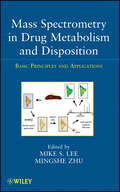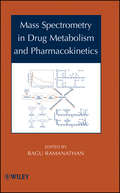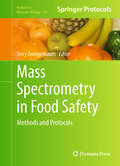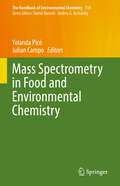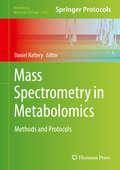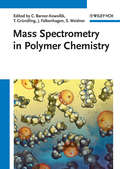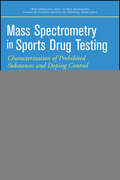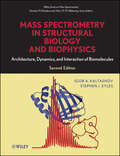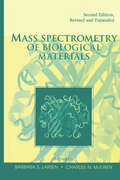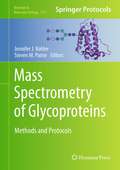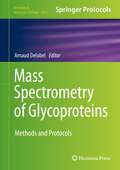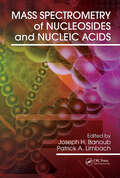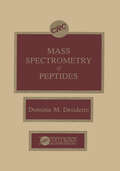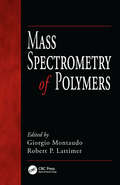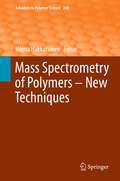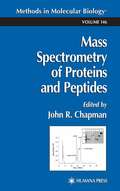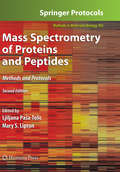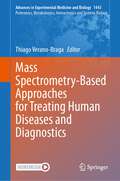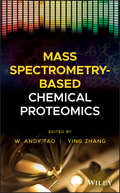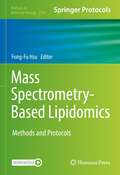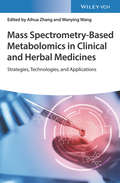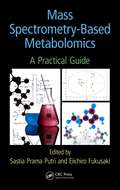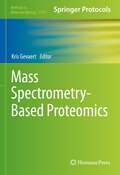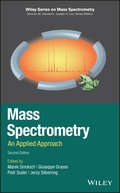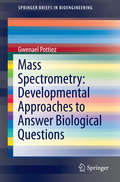- Table View
- List View
Mass Spectrometry in Drug Metabolism and Disposition
by Mike S. Lee Mingshe ZhuThis book examines the background, industrial context, process, analytical methodology, and technology of metabolite identification. It emphasizes the applications of metabolite identification in drug research. While primarily a textbook, the book also functions as a comprehensive reference to those in the industry. The authors have worked closely together and combine complementary backgrounds to bring technical and cultural awareness to this very important endeavor while serving to address needs within academia and industry It also contains a variety of problem sets following specific sections in the text.
Mass Spectrometry in Drug Metabolism and Pharmacokinetics
by Ragu RamanathanThis timely reference discusses mass spectrometry in drug metabolism and pharmacokinetic studies. With contributions by professionals from the pharmaceutical industry, this book begins with a review of current mass spectrometry techniques and applications, followed by discussions of various methods for using MS in drug metabolism studies and pharmacokinetics. Highlighting the critical importance of ADME studies for understanding how a drug is absorbed, distributed, metabolized, and excreted by the body, the book s focuses on the use of LC/MS and MALDI-MS. This is a valuable reference for scientists in the pharmaceutical industry, medicine, academia, and even those working in homeland defense.
Mass Spectrometry in Food Safety
by Jerry ZweigenbaumAs a key component of human survival, a safe and sufficient food supply is essential for a healthy and productive population throughout the world, so assurance that the food supply is clean and free of harmful substances is a global concern. In Mass Spectrometry in Food Safety: Methods and Protocols, experts in the field provide context to the subject through reviews of regulations in various countries, the current state-of-the art, and specific, detailed scientific methods being employed today. The volume thoroughly covers the key areas in food safety, such as detection of low level chemical residues, pesticide analysis aided by chromatographic techniques, and the revealing of mycotoxins and chemical contaminants from packaging materials. Written in the highly successful Methods in Molecular BiologyTM series format, method chapters contain introductions to their respective topics, lists of the necessary materials and reagents, step-by-step, readily reproducible laboratory protocols, and tips on troubleshooting and avoiding known pitfalls. Pertinent and cutting-edge, Mass Spectrometry in Food Safety: Methods and Protocols serves researchers with both understanding and appreciation for the contribution of mass spectrometry and its vital application to food testing and food safety.
Mass Spectrometry in Food and Environmental Chemistry (The Handbook of Environmental Chemistry #119)
by Yolanda Picó Julian CampoThis book reviews the latest advances in mass spectrometry (MS) techniques applied to food safety and environment quality, and it discusses the recent improvements in sample preparation and MS platforms for screening of emerging contaminants. Expert contributors discuss the current applications from omics to the screening of emerging contaminants and nanomaterials in food and environmental matrices, and particular attention is given to the opportunities that MS offers for guarantying food security and promoting the sustainable use of ecosystems. Divided into 13 chapters, the book covers topics such as the handling and preparation of food and environmental samples for MS, foodomics, environmental omics, ambient ionization techniques in food and environmental chemistry, and chip-based separation devices coupled to MS. Readers will also find a comprehensive overview of several MS techniques applied to food and environmental chemistry, including elemental, isotopic, chiral, ion mobility, chromatographic and imaging MS. This book will appeal not only to students and researchers, but also to professionals working with MS platforms in food safety and environmental quality. The different advances and promising applications described in this work will be of paramount importance for ensuring food safety and environment health for current and future generations.
Mass Spectrometry in Metabolomics
by Daniel RafteryMetabolomics is a fast growing field in systems biology and offers a powerful and promising approach for a large range of applications. Metabolomics focuses on deriving the concentrations and fluxes of low molecular weight metabolites in bio-fluids, cells or tissue, plants, foods and related samples and this information provides enormous detail on biological systems and their current status. Mass Spectrometry in Metabolomics: Methods and Protocols presents a broad coverage of the major mass spectrometry (MS)-based metabolomics methods and applications. MS is one of most powerful and commonly used analytical methods in metabolomics; because so many different MS systems are used in metabolomics, this volume includes a wide variety such as triple quads, time of flight, Fourier transform ion cyclotron resonance and even simple quadrupole systems. A wide range of studies are described, with samples ranging from blood and urine to tissue and even plants. Written in the successful Methods in Molecular Biology series format, chapters include introductions to their respective topics, lists of the necessary materials and reagents, step-by-step, readily reproducible protocols, and notes on troubleshooting and avoiding known pitfalls. Authoritative and easily accessible, Mass Spectrometry in Metabolomics: Methods and Protocols seeks to serve both professionals and novices with its well-honed methodologies in an effort to further the dynamic field of metabolomics.
Mass Spectrometry in Polymer Chemistry
by Steffen Weidner Jana Falkenhagen Christopher Barner-Kowollik Till GruendlingCombining an up-to-date insight into mass-spectrometric polymer analysis beyond MALDI with application details of the instrumentation, this is a balanced and thorough presentation of the most important and widely used mass-spectrometric methods.Written by the world's most proficient experts in the field, the book focuses on the latest developments, covering such technologies and applications as ionization protocols, tandem and liquid chromatography mass spectrometry, gas-phase ion-separation techniques and automated data processing. Chapters on sample preparation, polymer degradation and the usage of mass-spectrometric tools on an industrial scale round off the book.As a result, both entrants to the field and experienced researchers are able to choose the appropriate methods and instrumentations -- and to assess their respective strengths and limitations -- for the characterization of polymer compounds.
Mass Spectrometry in Sports Drug Testing
by Mario ThevisEnables you to detect, identify, and characterize hundreds of drugs that may be used by athletesMass spectrometry has become essential to sports drug testing. This book examines both the principles of sports drug testing and the use of mass spectrometry techniques and mass spectral data to detect, identify, and characterize hundreds of known and unknown drugs that athletes may use to enhance their performance. The author provides a detailed overview of the mass spectrometry of numerous classes of therapeutics and agents, various analyzers to detect low- and high-molecular weight drugs, as well as techniques to discriminate between endogenously produced and synthetically derived compounds.Mass Spectrometry in Sports Drug Testing begins with a full chapter dedicated to the history of sports drug testing. Next, the book provides the principles and techniques needed to maximize the specificity and sensitivity of mass spectrometric assays, including:Detailed, step-by-step assays with sample preparationDiscussion of both chromatographic separation and mass spectrometric analysisCharacterization of analytes in order to unequivocally identify banned substancesMass spectrometric behavior of low- and high-molecular weight analytesThroughout the book, descriptive examples illustrate the principles, advantages, and limitations of different assays.Mass Spectrometry in Sports Drug Testing not only sets forth the role mass spectrometry plays in detecting drug use among athletes, it also adds new insights into the health and ethical issues of doping in sports.
Mass Spectrometry in Structural Biology and Biophysics
by Igor A. Kaltashov Stephen J. EylesThe definitive guide to mass spectrometry techniques in biology and biophysics The use of mass spectrometry (MS) to study the architecture and dynamics of proteins is increasingly common within the biophysical community, and Mass Spectrometry in Structural Biology and Biophysics: Architecture, Dynamics, and Interaction of Biomolecules, Second Edition provides readers with detailed, systematic coverage of the current state of the art. Offering an unrivalled overview of modern MS-based armamentarium that can be used to solve the most challenging problems in biophysics, structural biology, and biopharmaceuticals, the book is a practical guide to understanding the role of MS techniques in biophysical research. Designed to meet the needs of both academic and industrial researchers, it makes mass spectrometry accessible to professionals in a range of fields, including biopharmaceuticals. This new edition has been significantly expanded and updated to include the most recent experimental methodologies and techniques, MS applications in biophysics and structural biology, methods for studying higher order structure and dynamics of proteins, an examination of other biopolymers and synthetic polymers, such as nucleic acids and oligosaccharides, and much more. Featuring high-quality illustrations that illuminate the concepts described in the text, as well as extensive references that enable the reader to pursue further study, Mass Spectrometry in Structural Biology and Biophysics is an indispensable resource for researchers and graduate students working in biophysics, structural biology, protein chemistry, and related fields.
Mass Spectrometry of Biological Materials
by Barbara S. Larsen Charles N. McewenSecond Edition provides up-to-the-minute discussions on the application of mass spectrometry to the biological sciences. Shows how and why experiments are performed and furnishes details to facilitate duplication of results.
Mass Spectrometry of Glycoproteins
by Steven M. Patrie Jennifer J. KohlerGlycosylation is the most abundant post-translational modification of proteins. Estimates vary widely, but a common assessment is that upwards of 50% of eukaryotic proteins are modified by some type of glycan. In Mass Spectrometry of Glycoproteins: Methods and Protocols, expert researchers in the field detail many of the methods that are now commonly used for glycoproteomics. These methods and techniques include robust sample preparation techniques; advanced chromatographic strategies for improving dynamic range; state-of-the-art mass spectrometry instrumentation and associated ionization and fragmentation methods; and informatics tools used for identifying glycoproteins and characterizing the associated glycans. Written in the highly successful Methods in Molecular BiologyTM series format, chapters include introductions to their respective topics, lists of the necessary materials and reagents, step-by-step, readily reproducible laboratory protocols, and key tips on troubleshooting and avoiding known pitfalls. Authoritative and practical, Mass Spectrometry of Glycoproteins: Methods and Protocol is an essential resource for those who work at the interface of glycobiology and mass spectrometry.
Mass Spectrometry of Glycoproteins: Methods and Protocols (Methods in Molecular Biology #2271)
by Arnaud DelobelThis volume presents methods used for the analysis of glycoproteins at different levels—intact, subunit, glycopeptide, and monosaccharide--, and discusses and solves most analytical challenges that a scientist working on glycoproteins may come across. The chapters in this book cover topics such as the role of glycosylation on the properties of therapeutic glycoproteins; different analytical methods to characterize glycosylation, from the intact proteins to the glycan level, for both N-linked and O-linked glycoproteins; mass spectrometry imaging methodology for glycosylation analysis in tissues; approaches to characterizing glycosylation on cultured cells; and the use of cloud computing to deploy mass spectrometry data analysis. Written in the highly successful Methods in Molecular Biology series format, chapters include introductions to their respective topics, lists of the necessary materials and reagents, step-by-step, readily reproducible laboratory protocols, and tips on troubleshooting and avoiding known pitfalls.Cutting-edge and thorough, Mass Spectrometry of Glycoproteins: Methods and Protocols is a valuable resource for scientists interested in learning more about this developing field.
Mass Spectrometry of Nucleosides and Nucleic Acids
by Joseph H. Banoub Patrick A. LimbachAssembling the work of an international panel of researchers, Mass Spectrometry of Nucleosides and Nucleic Acids summarizes and reviews the latest developments in the field and provides a window on the next generation of analysis. Beginning with an overview of recent developments, the book highlights the most popular ionization methods and illustra
Mass Spectrometry of Peptides
by Dominic M. DesiderioThe purpose of this book is to collect into one volume the research done on the mass spectrometry of peptides. It balances a range of topics including theory, instrumentation, analytical techniques, and biological applications. The scope of the work contains three major sections: ionization methods, instrumental developments, and analysis of peptides. It describes 252Cf plasma desorption and laser-induced multiphoton ionization methodology. This exciting resource covers many new areas, including continuous flow FAB, quantification of human neuropeptides, and peptide mapping. It also discusses Q-FTMS, cross-links, and metal ions.
Mass Spectrometry of Polymers
by Giorgio Montaudo Robert P. LattimerMass Spectrometry (MS) has rapidly become an indispensable tool in polymer analysis, and modern MS today complements in many ways the structural data provided by Nuclear Magnetic Resonance (NMR) and Infrared (IR) methods. Recent advances have sparked a growing interest in this field and established a need for a summary of progress made and results
Mass Spectrometry of Polymers – New Techniques
by Minna HakkarainenEmerging Mass Spectrometric Tools for Analysis of Polymers and Polymer Additives, by Nina Aminlashgari and Minna Hakkarainen. Analysis of Polymer Additives and Impurities by Liquid Chromatography/Mass Spectrometry and Capillary Electrophoresis/Mass Spectrometry, by Wolfgang Buchberger and Martin Stiftinger. Direct Insertion Probe Mass Spectrometry of Polymers, by Jale Hacaloglu Mass Spectrometric Characterization of Oligo- and Polysaccharides and Their Derivatives, by Petra Mischnick. Electrospray Ionization-Mass Spectrometry for Molecular Level Understanding of Polymer Degradation, by Minna Hakkarainen.
Mass Spectrometry of Proteins and Peptides
by John R. ChapmanJohn R. Chapman recreates the success of his earlier acclaimed book (Protein and Peptide Analysis by Mass Spectrometry, 1996) with a major new collection of cutting-edge methods in the analysis of proteins and peptides. Contributed by well-established investigators, each chapter provides background information before guiding the researcher step-by-step through the experimental process, with detailed instructions to help assure experimental success. The applications covered range widely and include protein sequencing, higher-order structure determination, epitope mapping, kinetics, quantitation, glycosylation analysis, and bacterial typing. Authoritative and eminently practical, Mass Spectrometry of Proteins and Peptides demonstrates the full scope of this versatile analytical technique. All protein chemists and biochemists, as well as bioanalytical scientists, who want to exploit these powerful methods in their work, will find this book indispensable.
Mass Spectrometry of Proteins and Peptides
by Ljiljana Paša-Tolic Mary S. LiptonWhen the last edition of this book was published in 2000, the field of proteomics was in its infancy. Now in its adolescence, proteomics is fundamentally transforming biological and medical research. Much of this transformation can be attributed to technological advancements, particularly in mass spectrometry. As a result of these rapid developments that have led to expanded areas of research and innovative applications, an update to Mass Spectrometry of Proteins and Peptides is not only worthwhile, but arguably mandatory. Spanning fields from microbial forensics and clinical applications to protein structure, dynamics and function, the following chapters written by leading experts serve as a forum for presenting some of the latest revolutionizing methods for mass spectrometry-based characterization of proteins and peptides. Staying faithful to the spirit of the Methods in Molecular BiologyTM series, all chapters are written in the same format, whereby each chapter opens with a basic description of the method, followed by a description of the protocol and then practical step-by-step instructions to ensure experimental success. Mass Spectrometry of Proteins and Peptides: Methods and Protocols, Second Edition is a valuable resource for novice and seasoned practitioners in the fields of biochemistry, molecular biology, clinical chemistry, immunology, genetic, microbiology and toxicology.
Mass Spectrometry-Based Approaches for Treating Human Diseases and Diagnostics (Advances in Experimental Medicine and Biology #1443)
by Thiago Verano-BragaThis book presents the technological advances in the field of mass spectrometry-based approaches for treating human diseases and diagnostics as well as the application of such approaches to study, in depth, human diseases, biomarkers discovery and validation, and to provide mechanistic insights of potential new therapeutics. This is an ideal book for students, technicians, researchers, and medical doctors that work in the field of mass spectrometry and proteomics
Mass Spectrometry-Based Chemical Proteomics
by W. Andy TaoPROVIDES STRATEGIES AND CONCEPTS FOR UNDERSTANDING CHEMICAL PROTEOMICS, AND ANALYZING PROTEIN FUNCTIONS, MODIFICATIONS, AND INTERACTIONS—EMPHASIZING MASS SPECTROMETRY THROUGHOUT Covering mass spectrometry for chemical proteomics, this book helps readers understand analytical strategies behind protein functions, their modifications and interactions, and applications in drug discovery. It provides a basic overview and presents concepts in chemical proteomics through three angles: Strategies, Technical Advances, and Applications. Chapters cover those many technical advances and applications in drug discovery, from target identification to validation and potential treatments. The first section of Mass Spectrometry-Based Chemical Proteomics starts by reviewing basic methods and recent advances in mass spectrometry for proteomics, including shotgun proteomics, quantitative proteomics, and data analyses. The next section covers a variety of techniques and strategies coupling chemical probes to MS-based proteomics to provide functional insights into the proteome. In the last section, it focuses on using chemical strategies to study protein post-translational modifications and high-order structures. Summarizes chemical proteomics, up-to-date concepts, analysis, and target validation Covers fundamentals and strategies, including the profiling of enzyme activities and protein-drug interactions Explains technical advances in the field and describes on shotgun proteomics, quantitative proteomics, and corresponding methods of software and database usage for proteomics Includes a wide variety of applications in drug discovery, from kinase inhibitors and intracellular drug targets to the chemoproteomics analysis of natural products Addresses an important tool in small molecule drug discovery, appealing to both academia and the pharmaceutical industry Mass Spectrometry-Based Chemical Proteomics is an excellent source of information for readers in both academia and industry in a variety of fields, including pharmaceutical sciences, drug discovery, molecular biology, bioinformatics, and analytical sciences.
Mass Spectrometry-Based Lipidomics: Methods and Protocols (Methods in Molecular Biology #2306)
by Fong-Fu HsuThis detailed volume covers conventional MS-based “shotgun lipidomics” by which samples are introduced by infusion or loop injection, as well as LC-MS-based lipidomics, which are becoming increasingly important due to the ever-increasing demand for a complete and precise lipid analysis of the complex and diversified lipids in nature. The volume features protocols applying chemical reactions, the on-line photochemical reactions combined with various MS methods for comprehensive characterization of various lipid classes, and quantification of specific and rare lipids. Written for the highly successful Methods in Molecular Biology series, chapters include introductions to their respective topics, lists of the necessary materials and reagents, step-by-step, readily reproducible laboratory protocols, and tips on troubleshooting and avoiding known pitfalls. Authoritative and practical, Mass Spectrometry-Based Lipidomics: Methods and Protocols serves as an invaluable guide for biochemists and mass spectroscopists who are interested in lipid studies.
Mass Spectrometry-Based Metabolomics in Clinical and Herbal Medicines: Strategies, Technologies, and Applications
by Aihua ZhangHighlights the importance and benefit of mass spectrometry-based metabolomics for identifying biomarkers that accurately screen for potential biomarkers of diseases Mass spectrometry-based metabolomics offer new opportunities for biomarker discovery in complex diseases and may provide pathological understanding of diseases beyond traditional technologies. It is the systematic analysis of low-molecular-weight metabolites in biological samples and has been applied to discovering and identifying the perturbed pathways. Currently, mass spectrometry-based metabolomics has become an important tool in clinical research and the diagnosis of human disease. Mass Spectrometry-Based Metabolomics in Clinical and Herbal Medicines comprehensively presents the current state, challenges, and applications of high-throughput mass spectrometry-based metabolomics such as metabolites analysis, biomarker discovery, technical challenges, discovery of natural product, mechanism interpretation of action, discovery of active ingredients, clinical application and precision medicine, and enhancing their biomedical value in a real world of biomedicine, shedding light on the potential for spectrometry-based metabolomics. It highlights the value of mass spectrometry-based metabolomics and metabolism to address the complexity of herbal medicines in systems pharmacology, especially, to link phytochemical analysis with the assessment of pharmacological effect and therapeutic potential. Each chapter has been laid out with introduction, method, up-to-date literature, identification of biomarker, and applications Covers the current state, challenges, and applications of high-throughput mass spectrometry-based metabolomics in the discovery of biomarker, active ingredients, natural product, etc. Constitutes a unique and indispensable practical guide for any phytochemistry or related laboratory, and provides hands-on description of new techniques Provides a guide for new practitioners of pharmacologists, pharmacological scholars, drug developers, botanist, researchers of traditional medicines. Mass Spectrometry-Based Metabolomics in Clinical and Herbal Medicines provides a landmark of mass spectrometry-based metabolomics research and a beneficial guideline to graduate students and researchers in academia, industry, and technology transfer organizations in all biomedical science fields.
Mass Spectrometry-Based Metabolomics: A Practical Guide
by Sastia Prama Putri Eiichiro FukusakiMass Spectrometry-Based Metabolomics: A Practical Guide is a simple, step-by-step reference for profiling metabolites in a target organism. It discusses optimization of sample preparation for urine, serum, blood, tissue, food, and plant and animal cell samples. Encompassing three different technical fields-biology, analytical chemistry, and informa
Mass Spectrometry-Based Proteomics (Methods in Molecular Biology #2718)
by Kris GevaertThis detailed volume explores contemporary techniques in mass spectrometry-based proteomics. After covering overall proteome coverage and the cellular surfaceome, the book delves into proximity-induced biotinylation, abduction of protein complexes in viral-like particles, and thermal proteome profiling, as well as protocols for identifying protein N-terminal acetylation, protein processing by proteases, protein N-glycosylation, and protein phosphorylation. The book also collects chapters on automated preparation of clinical samples, the analysis of formalin-fixed paraffin-embedded samples, protocols for the isolation of extracellular vesicles and for the monitoring of selected protein modifications in clinical samples, and, finally, structural proteomics. Written for the highly successful Methods in Molecular Biology series, chapters include introductions to their respective topics, lists of the necessary materials and reagents, step-by-step and readily reproducible laboratory protocols, and tips on troubleshooting and avoiding known pitfalls. Authoritative and practical, Mass Spectrometry-Based Proteomics serves as an ideal guide to its subject for both novices in the field of proteomics as well as specialists.
Mass Spectrometry: An Applied Approach (Wiley Series on Mass Spectrometry #20)
by Marek Smoluch Giuseppe Grasso Piotr Suder Jerzy SilberringProvides a comprehensive description of mass spectrometry basics, applications, and perspectives Mass spectrometry is a modern analytical technique, allowing for fast and ultrasensitive detection and identification of chemical species. It can serve for analysis of narcotics, counterfeit medicines, components of explosives, but also in clinical chemistry, forensic research and anti-doping analysis, for identification of clinically relevant molecules as biomarkers of various diseases. This book describes everything readers need to know about mass spectrometry—from the instrumentation to the theory and applications. It looks at all aspects of mass spectrometry, including inorganic, organic, forensic, and biological MS (paying special attention to various methodologies and data interpretation). It also contains a list of key terms for easier and faster understanding of the material by newcomers to the subject and test questions to assist lecturers. Knowing how crucial it is for young researchers to fully understand both the power of mass spectrometry and the importance of other complementary methodologies, Mass Spectrometry: An Applied Approach teaches that it should be used in conjunction with other techniques such as NMR, pharmacological tests, structural identification, molecular biology, in order to reveal the true function(s) of the identified molecule. Provides a description of mass spectrometry basics, applications and perspectives of the technique Oriented to a broad audience with limited or basic knowledge in mass spectrometry instrumentation, theory, and its applications in order to enhance their competence in this field Covers all aspects of mass spectrometry, including inorganic, organic, forensic, and biological MS with special attention to application of various methodologies and data interpretation Includes a list of key terms, and test questions, for easier and faster understanding of the material Mass Spectrometry: An Applied Approach is highly recommended for advanced students, young scientists, and anyone involved in a field that utilizes the technique.
Mass Spectrometry: Developmental Approaches to Answer Biological Questions
by Gwenael PottiezThe understanding of the events taking place in a cell, a biological fluid or in any biological system is the main goal of biology research. Many fields of research use different technology to assess those events. Mass spectrometry is one of those techniques and this undergoes constant evolution and adaptation to always enhance the accuracy of the information provided. Proteomics provides a large panel of data on protein identity and protein expression that were made possible by mass spectrometry. For several years now mass spectrometry has become central to performing proteomic research, however this powerful tool is under constant evolution to be more sensitive and more resolute. More importantly mass spectrometry became a field of research focusing on new applications. Indeed, the complexity in biological systems relies on the changes of expression of transcription of proteins but also on the post-translational modification of proteins, the structure of proteins and the interaction between proteins, amongst others. As of now, several investigations tried to improve the quantification of proteins by mass spectrometry, the determination of post-translational modifications, the protein-protein and protein-nucleic acids interaction or the proteins structures. This book is structured as follows: after a brief introduction of the usual and most popular applications for mass spectrometry in proteomics, the most recent research and developments in mass spectrometry-based methodologies will be explored.
